

Education Week Teacher Professional Development Sourcebook: Creative Writing in Science Class. Published Online: September 10, 2008 Published in Print: September 10, 2008, as Creative Writing in Science Class By Anthony Cody Making up their own stories helps students learn material in fresh ways.
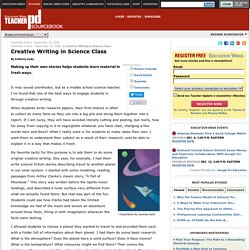
It may sound unorthodox, but as a middle school science teacher, I’ve found that one of the best ways to engage students is through creative writing. When students write research papers, their first instinct is often to collect as many facts as they can into a big pile and string them together into a report. Chemistry Journal Writing Prompts (Senior, Science) Science Journal – High School Chemistry Class Research shows that writing-to-learn can be effective in any classroom, and particularly in a science classroom.
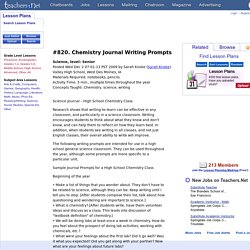
Writing encourages students to think about what they know and don’t know, and can help them to reflect on how they learn best. In addition, when students see writing in all classes, and not just English classes, their overall ability to write will improve. The following writing prompts are intended for use in a high school general science classroom. They can be used throughout the year, although some prompts are more specific to a particular unit.Sample Journal Prompts for a High School Chemistry ClassBeginning of the year• Make a list of things that you wonder about. They don’t have to be related to science, although they can be. High School - Visual Writing Prompts. McClellan et al, Writing Science in Hard Times. Home Journals Across the Disciplines McClellan et al, Writing Science in Hard Times Writing Across the Secondary School Curriculum Michael McClellan, Jefferson High School, Dawn Myelle-Watson, Jefferson High School, Brad Peters, Northern Illinois University, Debora Spears, Jefferson High School, and David Wellen, Jefferson High School.
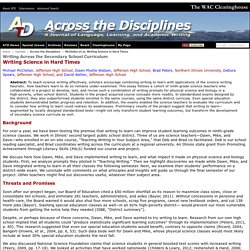
Common Core Standards: Writing in Science. The common core standards include a writing component for all educators of all grades, which can cause some mild anxiety among teachers who do not generally include writing as part of their instruction.
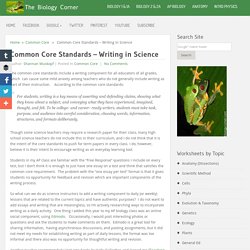
According to the common core standards: For students, writing is a key means of asserting and defending claims, showing what they know about a subject, and conveying what they have experienced, imagined, thought, and felt. To be college- and career- ready writers, students must take task, purpose, and audience into careful consideration, choosing words, information, structures, and formats deliberately. Though some science teachers may require a research paper for their class, many high school science teachers do not include this in their curriculum, and I do not think that it is the intent of the core standards to push for term papers in every class. PB311Xweb. Here are great high school chemistry writing prompts for the start of school and throughout the year. Title – Chemistry Journal Prompts By – Sarah Knoke Primary Subject – Science Secondary Subjects – Language Arts Grade Level – 10-12 Science Journal – High School Chemistry Class Research shows that writing-to-learn can be effective in any classroom, and particularly in a science classroom.

Writing encourages students to think about what they know and don’t know, and can help them to reflect on how they learn best. Writing in Science. S: Study the problem.
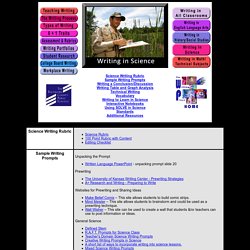
("S" the problem.) The first step is to highlight the question. Middle School Math and Science. As a middle school mathematics teacher, you probably feel like you don’t have enough time to teach all of your content within the course of a school year.
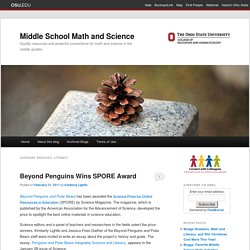
Why on earth would you ever want to add more material in the form of trade books when you can’t seem to finish your assigned textbook? Turns out that making time to incorporate children’s literature in your classroom can led to rich results. One of the most immediate benefits of using trade books is increasing student engagement. High quality trade books are written as to spark interest and create a desire to read. A good read. HartY0812. Teaching Science: CCSS For Literacy In Science Classroom.
The New Science Literacy by Bennett Daviss, Marlene Thier. Whether you're a teacher new to science or a veteran teacher of science, here's a powerful new tool for teaching the subject through language literacy.

This book explains how—how instructional synergy and power result from combining the two subjects. And it shows how—how teachers can use practical classroom techniques for combining these subjects at different grade levels, from elementary to high school. Unlike other books that concentrate on reading and writing, this book defines "literacy in science" as more encompassing: it includes speaking, listening, and media analysis.
Science and Literacy: Close Reading, CWA & more! - Boston Public Schools Science Department. NSTA Learning Center. Common Core Tips - Literacy in Science. In the last article, Dissecting Science Literacy Standards, we focused on common core standard 1, citing specific evidence within technical texts, which including some strategies for making documents in your curriculum align to this goal.
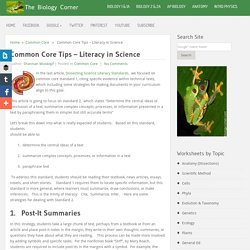
This article is going to focus on standard 2, which states “Determine the central ideas or conclusion of a text; summarize complex concepts, processes, or information presented in a text by paraphrasing them in simpler but still accurate terms” Let’s break this down into what is really expected of students. Based on this standard, students should be able to: Teaching Nonfiction Reading Skills in the Science Classroom [ACTIVITY] Posted by Bill Ferriter on Monday, 05/20/2013 I don't have a ton of time to write today -- I've spent the past week teaching and learning alongside of some really progressive thinkers in Australia -- so I figured I'd share a few handouts that I've been using in class this year to teach nonfiction reading skills in my sixth grade science classroom.
![Teaching Nonfiction Reading Skills in the Science Classroom [ACTIVITY]](http://cdn.pearltrees.com/s/pic/th/teaching-nonfiction-classroom-121021779)
Each lesson is tied directly to a standard in the Common Core Literacy in History, Science and Technical Subjects curriculum -- and each lesson is designed to be used in tandem with a current event connected to the concepts that our students study. Literacy Strategies for the Science Classroom. Note: see the attached "Resources.pdf" document for all materials referenced on this page. Vocabulary Strategies KIM Vocabulary Chart The KIM vocabulary chart is simple to use and can be done as a student handout or students can set up pages in their notebook for this strategy. The strategy is based upon a 3 column graphic organizer. Students write the key term (K) in the left column, information (I) about that term in the middle column, and provide a memory clue (M) in the form of a drawing in the last column.
Educational Leadership:What Students Need to Learn:Teaching Science Literacy. How to Teach High School Science: When Did I become a Reading Teacher. When Did I become a Reading Teacher Judy Jones When I first began to teach biology, it was because I loved the subject. I have always been fascinated by the discoveries in the biological sciences and the elegant intricacies of the processes that are being uncovered. Literacy in Science. Overview: Science and literacy learning make a dynamic duo, the perfect tag-team. Inquiry-based science requires students use the tools of science to seek answers to their questions about real world phenomena. Students compare their thinking, communicate with each other, and express their ideas through words and graphics. Integrating literacy.